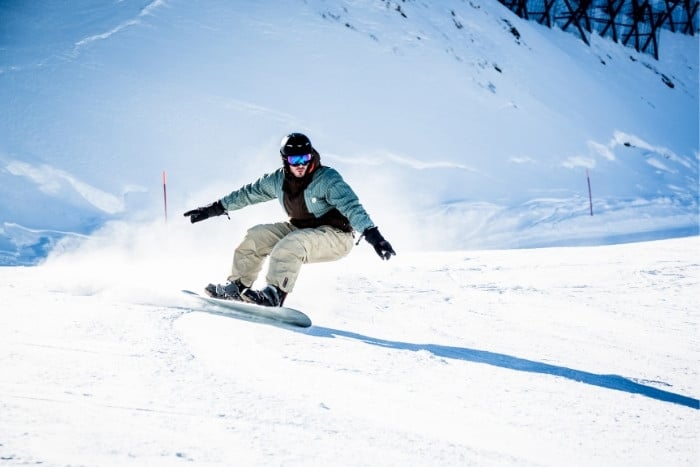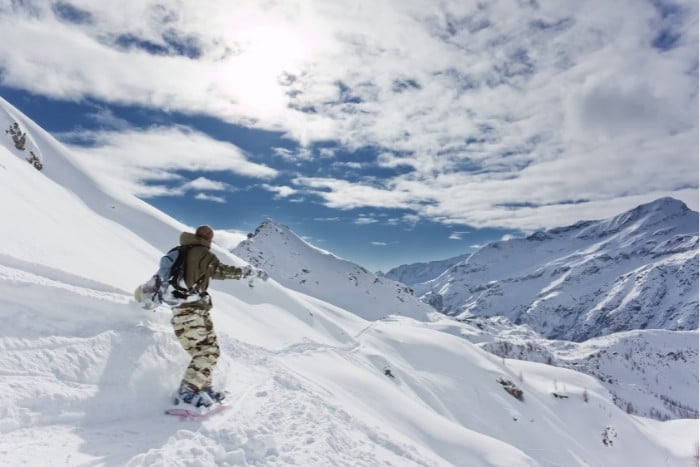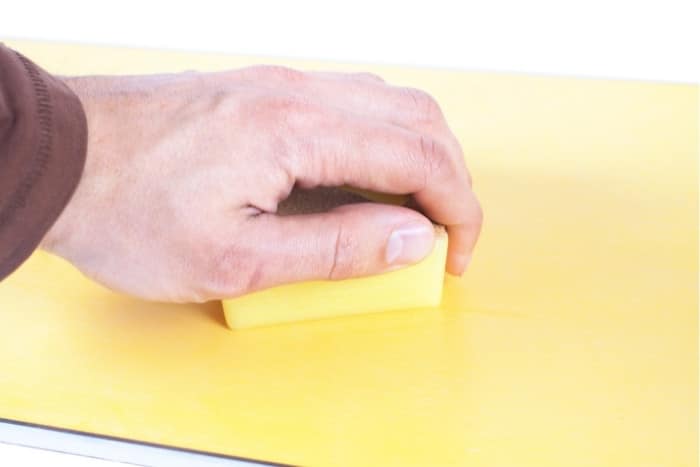If you’re fairly new to snowboarding, you may wonder what you can do to increase your speed? Many factors come into play when you are trying to ride faster, and some of these have to do with your individual skill level as a snowboarder, while things such as terrain also play an important role.
To ride faster, master the basics of snowboarding to get better at controlling the snowboard. With practice and time, riders usually gain the confidence to cruise at higher speeds. Having a board designed for faster conditions and maintaining a waxed base will also help improve speed.
Many other factors can influence riding speed, and we will examine them below.
How to Ride Faster as a Snowboarder?
Okay, so you have learned the basics of snowboarding and explored the mountains plenty and now want to step up your game.
Increasing your riding speed can increase your self-confidence as a snowboarder and help you further scale up your shredding experience. Hence, wanting more speed is the natural progression for all riders.
But before we jump on to the section where we discuss how to increase your speed, we would like you to ponder on this question: how fast is too fast?
Speed definition varies between riders, sporting events, and even terrain conditions. Take, for example, professional boarder X riders that constantly win Olympic medals.
They ride super fast compared to an average snowboarder. So let’s break down speeds with some basic stats to establish your goals and work towards them.
When starting out, you can reach speeds of 30 mph on the hill. And people who are slightly more experienced may hit around 40 mph when shredding on a basic run.
Professional snowboarders can reach speeds up to 70 mph when cruising down steep slopes, but they have years of experience to achieve these feats.
Understanding your skill level and the speeds you can achieve at this level is essential, as one of the major tips for increasing your speed revolves around pushing your limits while exercising caution.
Alright, let’s discuss things that can help you with your speed.

1. Practice Your Way Forward
This one may sound obvious, but you really need to practice to increase your speed.
Beginner snowboarders often can’t ride fast as they lack the control and balance required to keep their board steady at those higher speeds.
The inspiration to overcome fear and upskill your abilities can only come from enough practice. Once you’ve built your confidence, you will no longer feel stressed when riding fast.
Instead, you will automatically focus on maintaining control and balance. This process will gradually increase your snowboarding speed.
Thus, it’s just a matter of spending more time shredding and learning your way around the intermediate slopes.
Just remember your first ride on the snow; chances are you would have at least had a minor setback before you started picking up speed. And what is your current speed compared to your first day on snow?
You should be way faster, which is all due to more practice with snowboarding and the progress you have made in mastering the basics of riding. It is natural for snowboarders to seek speed and thrill.
But remember that the fastest achievable speed for a snowboarder is a unique number to each snowboarder and hence varies a lot between riders.
The skill aspect is based on your techniques, how well you balance and control the snowboard, and the terrain factors that come into play.
For example, fresh powder tends to slow down your ride compared to hard-pack snow. Knowing these differences will allow you to focus on stuff that is under your control to increase your speed.
2. Work on Your Balance
If it is all just practice, what are the things you should be focusing on during your training? It’s all about going back to the roots of your early training.
Particularly your early sessions where you were just learning to control your board while maintaining balance while turning.
Things to focus on would be those much more difficult runs where many trees push you out of your snowboarding comfort zone.
You can improve your balance off the hill by training your muscles and reflexes with a balance board. This way, outside factors will not affect you, and you can still progress.
To effectively control your snowboard, you need strong muscles and hips, and a balance board will help build these muscles and help you achieve the balance required to maintain high speeds.
3. Avoid Wet Snow When Training
Terrain plays a crucial role in helping you achieve your maximum speed. Hence, one thing to look out for when training is wet snow.
The water inside the snow crystals can act as adhesive and cause the snow crystals to attract and get stuck with each other.
This can slow down your ride considerably as they clump up under the pressure of the snowboard. Hence is not an ideal location when you’re practicing.
If you’re looking for the ideal conditions to gain speed, try groomers early in the morning, when they are still a little icy and haven’t been tracked out.
4. Know Correct Body Positioning
Don’t disregard the importance of maintaining a proper stance when riding fast. You should lean your body forward when riding to gain speed and balance.
To achieve the fastest speed possible, place around 65% of your body weight on the forward foot and the rest on your back foot, and tuck your body into a ball by squatting down slightly.
Moreover, when practicing, pick a spot with lots of free space away from trees, and avoid crowded runs, as they increase the chances of you running into other riders or them running into you.
You may also want to practice on steeper slopes with hard-packed snow or rollers, which will naturally increase your speed.
5. Cautiously Push Your Limits
Fear is the biggest roadblock people experience when they try to ride fast, and the new experience of riding at higher speeds and the thrill can overwhelm your senses.
Because of this, you might stick with speeds and slopes that you’re comfortable with and not feel motivated to push those boundaries.
Chase after terrains that are a challenge at your current skill level. But also keep safety in mind and exercise caution.
The learning curve should be gradual and shouldn’t have any sudden bumps in difficulty that could derail the progress you have made in the meantime.
The best way is to switch between beginner and intermediate slopes. Always be mindful and honest about things you can do at your level and plan accordingly.
But, indeed, you can easily increase your skill level by constantly seeking advanced runs.

6. Socialize and Learn From Others
If the solo approach is not your thing, you can also team up with other snowboarders who are faster than you and learn from the collective experience.
Just try to follow your friends and stay on the same line while trying to catch up to their speed.
By doing this, not only do you have someone to look up to while practicing, but this also takes away your anxiety from pushing your limits because you have a strong anchor on which to focus your attention.
So, tag along with people of all skill levels and mutually help each other in your journey. And don’t disregard online sources for learning techniques that can help you ride faster.
Watch pros on YouTube cruising down fast and observe how they do it.
Many of these channels post videos frequently, and watching them perform might just give you the extra inspiration needed to push your limits. If those riders can do it through consistent effort, so can you!
Good Design Features for a Fast Snowboard
If you love speeding down the slopes, you might wonder about the best snowboard for fast riding. Snowboards that ride fast have features that set them apart from other boards.
They usually have camber profiles with a stiff flex and are elongated in length. All-mountain and freeride snowboards are excellent for riders who seek steeper slopes.
Their ability to maintain stability at higher speeds makes them an instant grab for many snowboarders. Here are some design features you should consider when choosing a fast snowboard.
1. Directional Design for Speed
The number one feature we recommend for you to look out for is direction design, as a directional design allows for faster riding.
You see, boards with this type of design often have a bigger nose portion and stiff tails, which is great for fast riding.
The nose portion reinforces weight and gravitational pull on the snowboard and helps with a faster descent on steeps, while the stiffer tail aids in maintaining control of your back foot.
2. Pick Shallow Radius Sidecuts
The next thing to keep in mind is the sidecut. In general, the larger the sidecut radius, the more stable the snowboard will be at higher speeds. Hence go for a shallow radius sidecut.
Although there are some downsides, such as difficulty initiating sharper turns, their ability to hold an edge at higher speeds is a much-needed bonus for speed riders.
3. Go for a Longer Snowboard
If speeding down slopes is your priority, then longer snowboards are a much better option. The stability these boards provide at higher speeds is greater than shorter boards.
Because shorter boards have a lower surface area and hence have less contact with the snow, and although they shred faster down the hills, they can also become unreliable at higher speeds.
Due to their bigger surface area, longer boards make more contact with snow on their edges, giving the extra grip and stability needed at higher speeds.
4. Choose Average Width for the Snowboard
In general, narrow snowboards tend to be faster because of the reduced friction from the decreased surface area of the board.
But as we discussed earlier, a bigger surface area means more stability, hence narrower width design leads to stability issues at higher speeds.
To overcome this drawback, freeride and all-mountain boards that are meant for fast riding stick to average board width but slightly reduce the length at the waist portion of the board.
This gives the snowboard a good balance between stability and speed and, of course, good edge control.
5. Camber Profile and Stiffer Flex Are Better
Fast riders prefer stiffer flex, and a flex rating above eight makes the snowboard excellent for some speed riding.
Again, these boards provide the best edge control when carving compared to boards with a softer flex, which tends to be forgiving for new riders and awesome for tricks and air but lose their reliability when put to the test at steeper slopes.
As for the profile, a traditional camber works best for fast riding, thanks to the increased edge contact when on snow.
Can Waxing Your Board Make You Go Faster?
Most experienced snowboarders know that waxing your snowboard’s base increases its lifespan and keeps it in a healthy condition.
This is because a snowboard is just a piece of wood with a base made up of pores that can dry out, which lowers its agility and performance. Waxing hydrates your board and keeps it from drying out.
But why should you be concerned about this? Waxing, apart from keeping your board in good condition, can also make your ride go faster.
This is because the process of rehydrating your board also increases its gliding capabilities. And this is good news for people that love to shred at high speeds.
Without this, riders can have trouble maintaining their speed, and the board simply won’t slide well as it used to.

The Right Time to Do It?
So how often should you wax your board to maintain its performance? It’s advised that you should hot wax your snowboard after three to four days of shredding.
This ensures the snowboard stays hydrated and maintains its glide under various snowboarding conditions.
The most important thing to remember is the type of wax used for waxing changes based on the temperature you will be shredding in.
So, when riding in cooler weather, stick to cold weather waxes. And when it’s warm, warmer weather waxes are the preferred choice.
If you can’t make up your mind based on the weather, there are waxes designed for all temperatures (this type of wax usually comes pre-packaged when you buy a wax kit).
Waxing is fairly easy and can be done at home using wax and some common items you have lying around the house.
Waxing your board regularly will ensure your board maintains speed and stays in good condition.
Final Thoughts
There are several ways to increase your snowboarding speed. But the most efficient way is practicing balance exercises that let you control and maintain your balance on the snowboard when cruising.
To quickly make progress, move out of your comfort zone and seek runs that are challenging at your current skill level. Moreover, choose boards that have unique features suited for higher speeds.
These are longer boards with a stiffer flex and have a directional design.
Also, don’t forget to maintain your snowboard in good condition, as failing to do so might affect the performance and speed of your board. Happy cruising!
